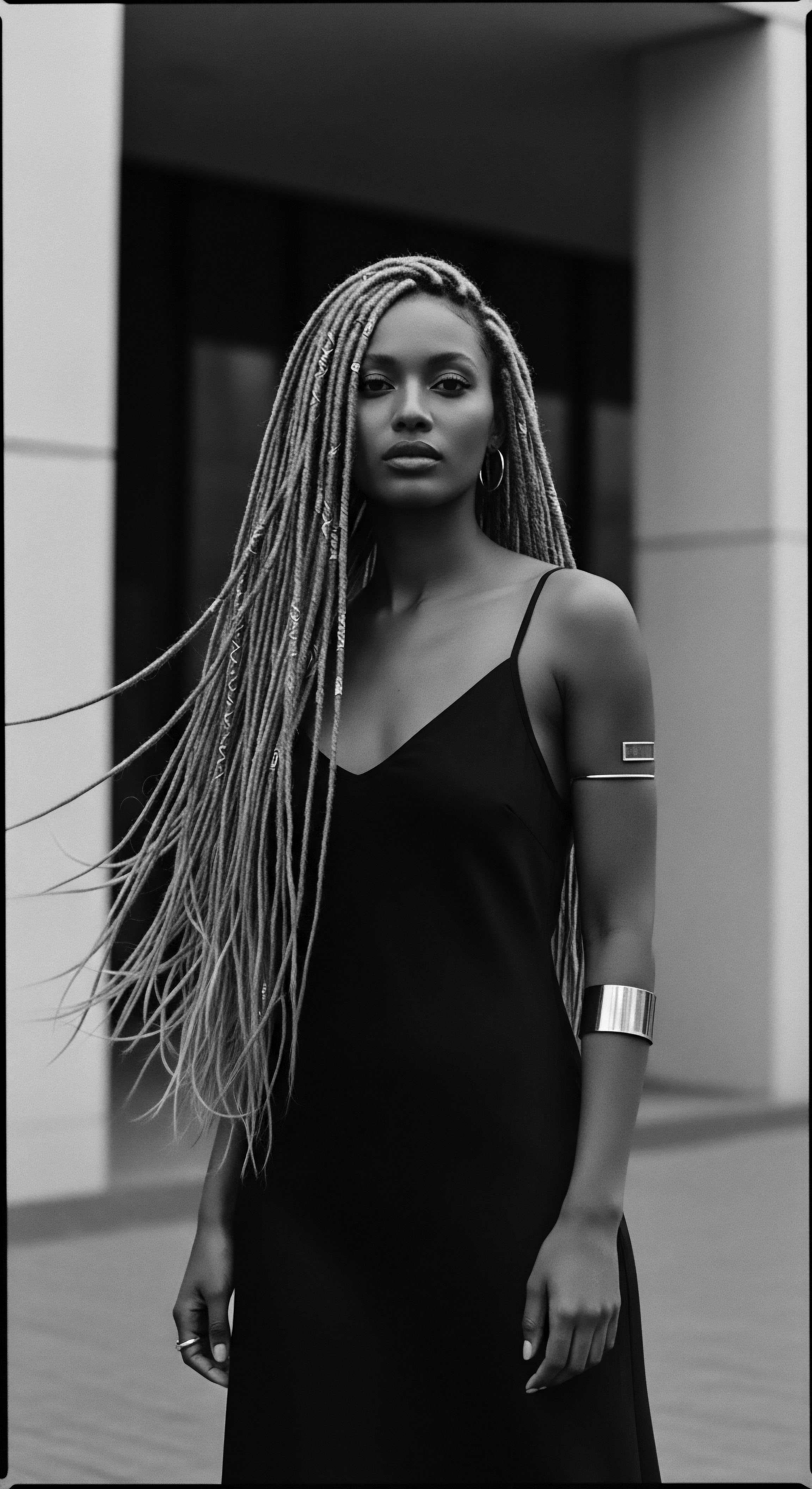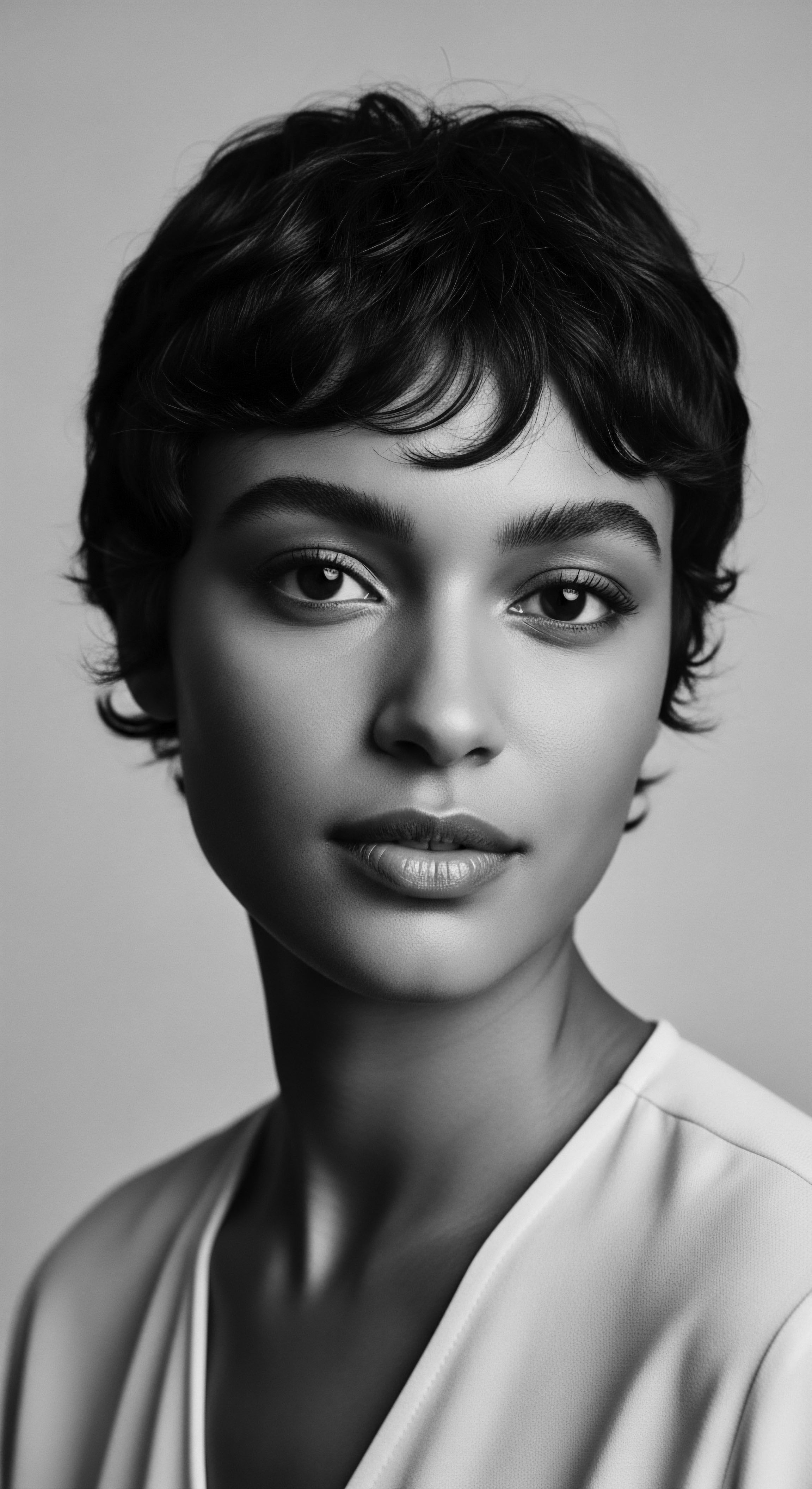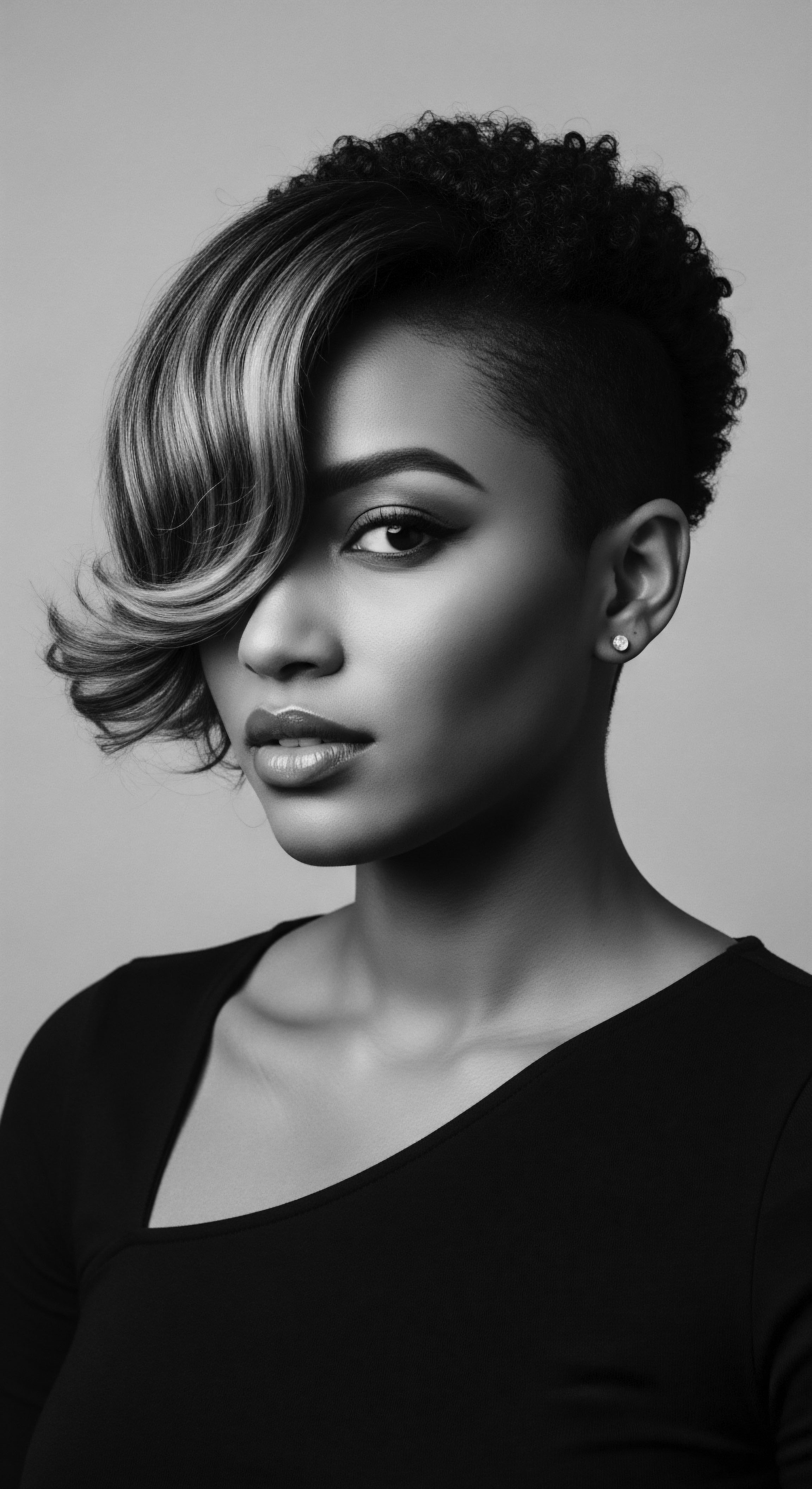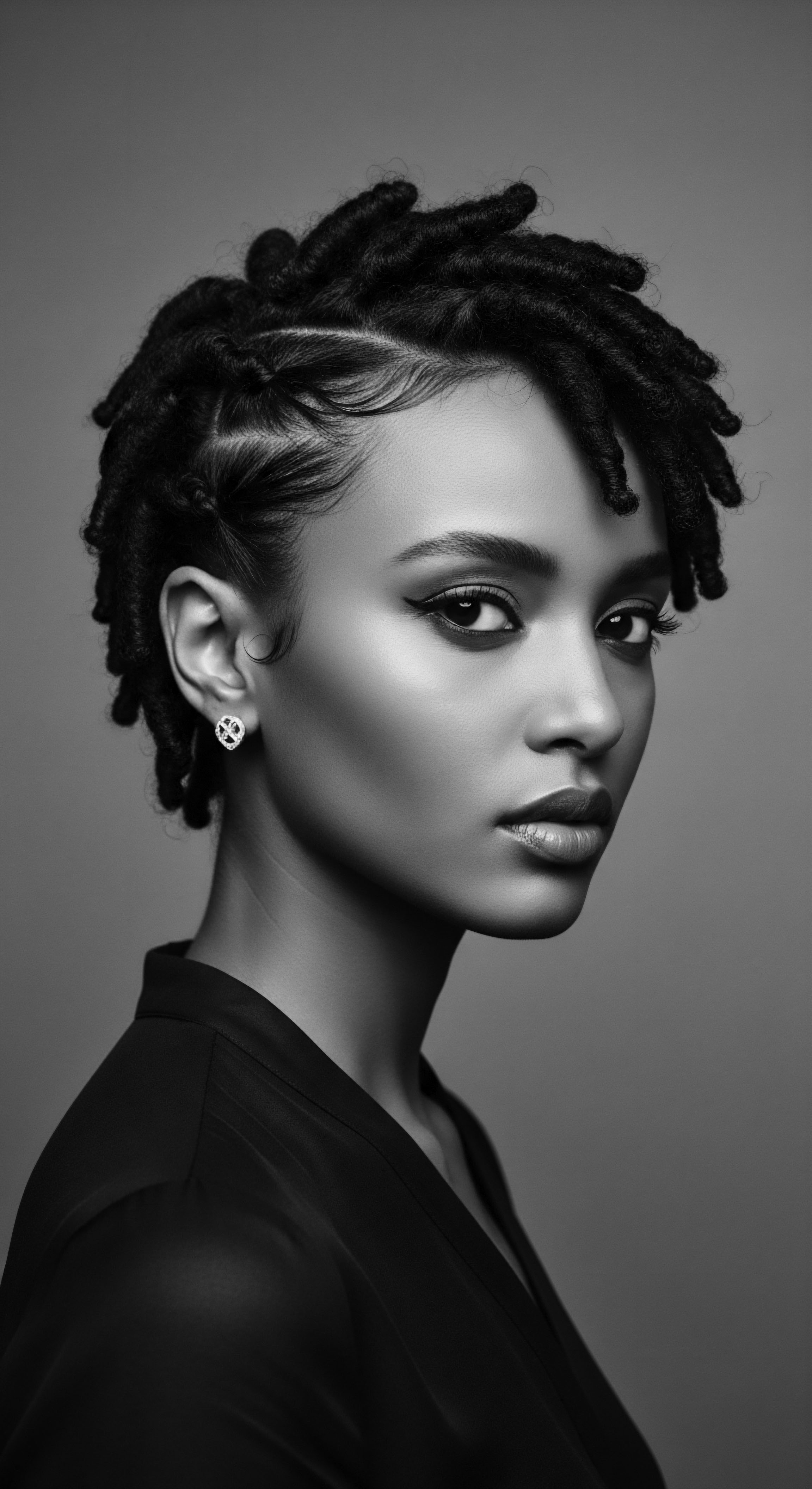
Fundamentals
Traditional African Oils represent a lineage of botanical wisdom, deeply interwoven with the fabric of textured hair heritage across the African continent and its diaspora. This concept signifies more than mere cosmetic application; it stands as an explanation of centuries-old practices, a description of the profound relationship between indigenous communities and their natural environment, and an interpretation of holistic well-being where hair care is inseparable from spiritual and cultural identity. These oils, often extracted from seeds, nuts, or fruits of indigenous plants, served as fundamental components in ancestral grooming rituals, offering both nourishment and protection to diverse hair textures.
The meaning of Traditional African Oils extends beyond their chemical composition; it holds a profound significance rooted in the daily lives and communal bonds of African peoples. These botanical extracts were not simply ingredients; they were agents of care, connection, and continuity. From the arid expanses of the Kalahari to the lush forests of West Africa, different communities identified and utilized oils unique to their ecosystems, each contributing to a rich tapestry of hair care traditions. The application of these oils was frequently a communal activity, passed down through generations, embodying shared knowledge and collective identity.
Traditional African Oils are a testament to ancestral ingenuity, transforming nature’s bounty into profound expressions of hair heritage and communal care.

The Elemental Connection
The designation of these substances as “Traditional African Oils” clarifies their origin and historical application. They are distinct from modern synthetic compounds, drawing their efficacy directly from the elemental biology of the plants from which they derive. For communities relying on the land for sustenance and healing, understanding the properties of these oils was a matter of practical survival and cultural continuity. Their presence in daily rituals underscored a deep reverence for nature’s provisions and an intuitive grasp of how to harness them for personal and collective flourishing.
A primary example of such an oil is Shea Butter (Vitellaria paradoxa), often called “women’s gold” in West Africa. Its significance extends beyond its moisturizing properties; it represents economic empowerment for countless women who traditionally harvest and process the nuts. The explication of shea butter’s role reveals a product that nourishes hair and skin while simultaneously sustaining livelihoods and reinforcing communal structures.
- Shea Butter (Ori) ❉ A rich, creamy butter from the shea tree, widely used across West Africa for its moisturizing and protective qualities, particularly beneficial for textured hair prone to dryness. It also holds deep cultural and economic importance.
- Baobab Oil ❉ Sourced from the “Tree of Life” (Adansonia digitata), this oil is found in various African regions and is valued for its nourishing properties, including omega fatty acids and vitamins, which contribute to hair strength and scalp health.
- Marula Oil ❉ Extracted from the kernels of the marula fruit (Sclerocarya birrea), prevalent in Southern Africa, this light oil is recognized for its hydrating and antioxidant qualities, historically used for skin and hair protection in harsh climates.

Early Practices and Rituals
The early uses of these oils were embedded in comprehensive hair care rituals that transcended mere aesthetics. Hair, in many African societies, served as a powerful visual language, communicating status, age, marital standing, and even spiritual connection. The careful application of oils was an integral step in maintaining these intricate styles and ensuring the health of the hair and scalp.
In Yoruba culture, for instance, hair was seen as the most elevated part of the body, and elaborate braided styles were often used to send messages to the gods. The creation of these styles, such as Ìrun Dídì (cornrows) and Ìrun Kíkó (threaded hairstyles), involved meticulous preparation, including the use of natural oils like coconut oil or shea butter to keep the hair soft, shiny, and pliable for braiding. This historical example clarifies the symbiotic relationship between the oils and the cultural artistry of hair.
| Oil/Butter Shea Butter (Ori) |
| Region of Prominence West Africa |
| Primary Traditional Hair Use Moisturizing, softening, protective barrier for intricate styles. |
| Oil/Butter Baobab Oil |
| Region of Prominence Various African regions |
| Primary Traditional Hair Use Scalp nourishment, hair strength, frizz control. |
| Oil/Butter Marula Oil |
| Region of Prominence Southern Africa |
| Primary Traditional Hair Use Hydration, protection from harsh elements, scalp soothing. |
| Oil/Butter Kalahari Melon Seed Oil |
| Region of Prominence Kalahari Desert (Southern Africa) |
| Primary Traditional Hair Use Moisturizing, protecting from sun damage, promoting hair growth. |
| Oil/Butter These oils were integral to ancestral hair care, reflecting deep ecological knowledge and cultural reverence for hair. |

Intermediate
Moving beyond the foundational understanding, the intermediate meaning of Traditional African Oils reveals a deeper engagement with their properties and their enduring relevance to textured hair care. This delineation considers the subtle interplay between the oil’s biological composition and its practical application, particularly for hair textures that often require specialized care. The historical continuity of these oils speaks to their sustained efficacy, validated not just by ancestral practice but increasingly by contemporary scientific inquiry.
The interpretation of these oils as ‘living library’ entries underscores their dynamic presence, evolving from ancient remedies to celebrated ingredients in modern wellness. This progression is not a departure from their origins but rather an expansion of their reach, allowing more individuals to connect with the wisdom of African hair traditions. Understanding their substance involves recognizing how different oil profiles cater to the unique needs of textured hair, from tight coils to looser curls, all of which benefit from specific types of nourishment and sealing properties.

Structural Benefits for Textured Hair
Textured hair, characterized by its elliptical cross-section and varying curl patterns, possesses inherent structural differences that influence its moisture retention and susceptibility to breakage. The natural oils produced by the scalp, known as sebum, often struggle to travel down the coiled hair shaft, leading to dryness, particularly at the ends. This intrinsic characteristic makes external moisturization, traditionally provided by African oils, especially pertinent.
Traditional African Oils offer a critical solution to this challenge. Their emollient properties help to seal the hair’s cuticle, thereby minimizing moisture loss and enhancing elasticity. For instance, Baobab Oil, rich in omega fatty acids and vitamins, provides a lightweight yet deeply nourishing effect, promoting hair growth and taming frizz by smoothing the cuticle. This specific benefit addresses a common concern for individuals with textured hair, supporting manageability and reducing the propensity for breakage.
The consistent use of Traditional African Oils speaks to a long-held wisdom regarding the moisture needs of textured hair, a practice now increasingly affirmed by scientific observation.

The Tender Thread of Communal Care
Beyond the individual strand, the significance of these oils is profoundly tied to communal practices. Hair care rituals in African societies were, and often remain, deeply social events. These were moments for intergenerational bonding, storytelling, and the transmission of cultural knowledge. The application of oils was a tactile expression of care, a tender thread connecting mothers to daughters, elders to youth.
The very act of oiling hair became a ritual of bonding and identity. For example, in many West African cultures, the process of preparing and applying shea butter was a collective endeavor, often led by women, reinforcing social ties and shared heritage. This shared experience provided not only physical benefits for the hair but also strengthened the cultural legacy, teaching patience, precision, and the value of self-care as a community act.
- Intergenerational Learning ❉ The practical knowledge of oil extraction, preparation, and application was passed down through observation and participation, ensuring the continuity of traditional practices.
- Social Cohesion ❉ Hair grooming sessions, often involving multiple individuals, fostered conversation, shared laughter, and strengthened familial and community bonds.
- Cultural Identity Markers ❉ The specific oils used, alongside the hairstyles created, often communicated tribal affiliation, social status, and personal milestones, reinforcing collective identity.

Bridging Ancient Wisdom and Modern Understanding
The journey of Traditional African Oils from ancient hearths to contemporary beauty routines illustrates a powerful convergence of ancestral wisdom and modern scientific understanding. While traditional knowledge often derived from observation and experience, today’s scientific methods offer a deeper elucidation of the chemical and physical mechanisms at play. For instance, studies on Abyssinian Seed Oil (Crambe abyssinica), though not exclusively African, offer insights into how certain oils can soften the hair cuticle and protect melanin from solar degradation, contributing to reduced breakage and improved manageability for African hair. This kind of research begins to provide a scientific framework for the benefits long observed by traditional practitioners.
The ongoing research into these oils aims to understand their precise impact on the unique structure of textured hair. While some studies, such as a systematic review of coconut, castor, and argan oils, note limited clinical evidence for hair growth from some oils, they confirm benefits like treating brittle hair and improving hair quality. This highlights the need for continued investigation, ensuring that modern formulations respect the integrity and efficacy of these heritage ingredients. The growing interest in these oils in the Western world also reflects a shift, moving away from previously negative perceptions of hair oiling to an appreciation for its long-standing benefits.

Academic
The academic definition of Traditional African Oils transcends a simple explanation of their botanical origins or cosmetic uses; it represents a profound examination of their significance within the complex socio-cultural, economic, and biological landscapes of African and diasporic communities. This explication requires a multi-disciplinary lens, drawing from ethnobotany, cultural anthropology, historical studies, and hair science to construct a comprehensive understanding. The meaning of these oils is thus understood as a dynamic construct, shaped by centuries of adaptation, resilience, and the enduring quest for identity through hair.
At its core, Traditional African Oils refer to a distinct category of plant-derived lipids, typically extracted through ancestral methods (e.g. cold-pressing, fermentation, or artisanal rendering), whose application in hair and scalp care is deeply rooted in indigenous African knowledge systems and communal practices. Their designation as ‘traditional’ underscores their historical continuity, pre-dating colonial influences and often persisting despite attempts to devalue African hair textures and care rituals. This specific delineation moves beyond a generic understanding of ‘natural oils’ to emphasize their particular cultural provenance and the sophisticated, albeit often unwritten, scientific principles embedded within their historical utilization.

The Bio-Cultural Nexus ❉ Kalahari Melon Seed Oil as a Case Study
To grasp the profound meaning of Traditional African Oils, a deep exploration of specific examples offers unparalleled insight. Consider Kalahari Melon Seed Oil (Citrullus lanatus), often known as Tsamma oil. This botanical treasure, indigenous to the Kalahari Desert spanning Namibia, Botswana, and South Africa, offers a compelling case study of a Traditional African Oil whose significance is inextricably linked to both ecological adaptation and human resilience. For over 4,000 years, the San People of the Kalahari have utilized this melon, not only as a crucial source of water in an arid environment but also, critically, by grinding its seeds into a paste for skin protection against harsh desert elements, and its oil for hair care.
The scientific elucidation of Kalahari Melon Seed Oil reveals a lipid profile exceptionally rich in Linoleic Acid (an omega-6 fatty acid, often comprising 50-70% of its composition) and Oleic Acid, alongside significant levels of Vitamin E and beta-carotene. This biochemical makeup provides potent antioxidant and emollient properties. For textured hair, particularly in challenging environmental conditions, this oil’s ability to regulate hydration and restructure the epidermis, as well as its non-comedogenic nature, is invaluable.
The San people’s traditional application of this oil to hair and scalp for moisturizing and promoting hair growth, even as a form of sunblock when mixed with pulp, demonstrates an intuitive understanding of its photoprotective and nourishing capabilities long before modern spectrophotometry or thermogravimetric analysis. This ancestral wisdom, honed through millennia of lived experience and keen observation of the natural world, provided practical solutions for hair health in extreme climates.
The legacy of Traditional African Oils is a testament to indigenous ecological intelligence, where botanical properties were intimately understood and applied for holistic well-being.
This nuanced understanding highlights that the traditional use of Kalahari Melon Seed Oil was not merely anecdotal; it was a sophisticated practice rooted in an empirical knowledge system. The oil’s capacity to penetrate hair fibers, delivering essential fatty acids that contribute to cellular integrity and suppleness, directly addresses the inherent challenges of moisture retention in highly coiled hair textures. The traditional methods of cold-pressing the sun-dried seeds preserved these delicate compounds, ensuring maximum efficacy—a process now validated by modern appreciation for cold-pressed oils in cosmetic science.

The Impact of Colonialism and the Diaspora’s Resilience
The historical trajectory of Traditional African Oils and their associated hair practices cannot be fully appreciated without acknowledging the profound disruption caused by colonialism and the transatlantic slave trade. As enslaved Africans were forcibly removed from their ancestral lands, they were stripped of their cultural practices, including their intricate hair rituals and access to indigenous oils and tools. This deliberate dehumanization included the shaving of hair, a symbolic act of stripping identity and severing spiritual connection. The imposition of Eurocentric beauty standards led to the negative pathologization of tightly coiled hair, fostering an internalized perception of inferiority that persisted for generations.
Despite these oppressive forces, the spirit of ancestral hair care, though often adapted and disguised, persisted in the diaspora. Enslaved individuals, even with limited resources, continued to utilize whatever oils were available, such as butter or goose grease, to maintain their hair on designated days of rest. This resilience underscores the deeply ingrained cultural significance of hair care.
The subsequent “natural hair movement,” gaining momentum during the Civil Rights Era and re-emerging powerfully in recent decades, represents a conscious reclaiming of this heritage. It is a collective act of self-acceptance and a rejection of imposed beauty norms, celebrating the innate beauty of textured hair and, by extension, the Traditional African Oils that historically nourished it.
A study published in the Journal of Drugs in Dermatology (Phong et al. 2022) highlights how oils like coconut, castor, and argan, though globally used, are “culturally rooted in current and historical Indian and African heritages.” The authors note that dermatologists often recommend patients continue using hair oils not primarily based on clinical efficacy alone, but also due to the “deeply rooted cultural practices of some skin of color patients”. This observation, while not a statistic, provides a powerful qualitative insight into the enduring significance of these oils within lived experiences, even in contemporary clinical contexts. It speaks to the recognition of cultural continuity as a valid consideration in wellness, affirming the inherent value beyond empirical metrics alone.

The Unbound Helix ❉ Modern Validation and Future Directions
The contemporary understanding of Traditional African Oils involves a rigorous scientific inquiry that often validates long-standing traditional claims. Modern research investigates their chemical profiles, including fatty acid composition, vitamin content, and antioxidant capacities, to explain their observed benefits. For example, studies on Abyssinian Seed Oil (ASO) demonstrate its ability to soften the hair cuticle and protect melanin from solar radiation, suggesting a mechanism for improved manageability and reduced breakage in African hair. This scientific corroboration strengthens the academic foundation for appreciating these oils, moving them beyond mere anecdotal evidence.
The role of Traditional African Oils in shaping future hair care paradigms is also a critical aspect of their academic definition. The increasing demand for natural, ethically sourced ingredients has brought these oils to the forefront of the global beauty industry. This movement, however, requires careful consideration of sustainable sourcing and fair trade practices to ensure that the economic benefits genuinely reach the communities that have preserved this knowledge for centuries. The ongoing research, such as that focusing on identifying African plants for hair treatment and care with potential for hair growth, further solidifies the academic interest in these traditional remedies.
The complex relationship between hair structure and oil properties continues to be a subject of academic inquiry. African hair, with its unique elliptical cross-section and higher lipid content, interacts with oils in distinct ways. The very act of oiling, traditionally a pre-wash ritual in many African and South Asian cultures, is now gaining traction globally, prompting further scientific investigation into its protective effects against porosity and damage. This convergence of historical practice and scientific validation provides a robust framework for the continued study and appreciation of Traditional African Oils as more than just ingredients, but as profound cultural artifacts and scientific marvels.

Reflection on the Heritage of Traditional African Oils
The journey through the definition of Traditional African Oils reveals a narrative far richer than simple botanical classification. It is a profound meditation on textured hair, its heritage, and its care, presented as a living, breathing archive within Roothea’s vision. From the elemental biology echoing from the source, through the tender thread of communal care, to the unbound helix of identity and future possibility, these oils embody a continuous legacy. They whisper stories of ancestral wisdom, of hands that meticulously extracted precious liquids from seeds and nuts, and of communities that wove hair care into the very fabric of their social and spiritual lives.
The enduring significance of these oils lies not only in their proven ability to nourish and protect textured hair, but also in their symbolic power. They stand as resilient markers of identity, particularly for Black and mixed-race individuals who navigate a world that has often sought to diminish their natural beauty. The deliberate act of choosing a Traditional African Oil for one’s hair is an affirmation of lineage, a gentle rebellion against imposed standards, and a celebration of an inherited crown.
It is a connection to a deep past, a vibrant present, and a hopeful future where every strand tells a story of strength, beauty, and unwavering heritage. This wisdom, carried forward through generations, continues to guide us toward a more holistic and respectful approach to hair, recognizing it as a sacred extension of self and an enduring link to ancestral roots.

References
- Byrd, A. D. & Tharps, L. D. (2014). Hair Story ❉ Untangling the Roots of Black Hair in America. St. Martin’s Griffin.
- Karanja, M. (2007). The History of African Hair. University of California Press.
- McIntosh, M. (2009). Gender, Kinship, and Property Rights ❉ Yoruba Customary Law in Colonial Nigeria. Stanford University Press.
- Nnoruka, E. (2005). Hair Loss in African Women ❉ A Clinical and Epidemiological Study. Journal of the American Academy of Dermatology.
- Oyelami, A. (2006). Yoruba Hairdressing ❉ Art, Identity, and Culture. Indiana University Press.
- Phong, C. Lee, V. Yale, K. Sung, C. & Mesinkovska, N. (2022). Coconut, Castor, and Argan Oil for Hair in Skin of Color Patients ❉ A Systematic Review. Journal of Drugs in Dermatology, 21(7), 751-757.
- Riggs, M. (1987). Ethnic Notions. California Newsreel.
- Tharps, L. D. (2001). Hair Story ❉ Untangling the Roots of Black Hair in America. St. Martin’s Press.
- Tolu, O. (2020). Soul Hairitage Series ❉ Exploring African Hair Culture. Self-published work.
- Willie, A. (2021). The Gele and its Cultural Significance in Yoruba Weddings. Journal of African Cultural Studies.
